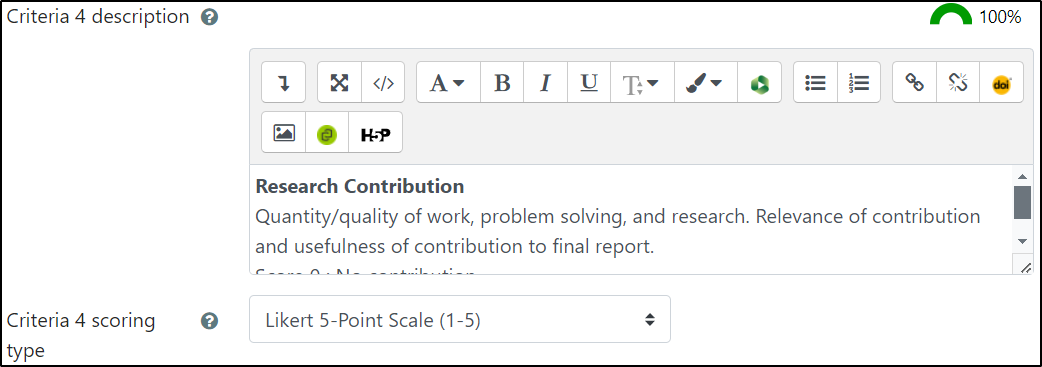Peer Work
![]() Peer Work is a Moodle activity that allows students to assess each other’s performance against a range of criteria. Typically, teachers have set a mark for a group’s work on an assignment and the Peer Work tool can be used to modify this mark to arrive a differentiated mark for each student.
Peer Work is a Moodle activity that allows students to assess each other’s performance against a range of criteria. Typically, teachers have set a mark for a group’s work on an assignment and the Peer Work tool can be used to modify this mark to arrive a differentiated mark for each student.
How to set up a Peer Work activity
You will need to have your students in groups within Moodle before you can use a Peer Work Activity.
Add a Peer Work Activity to your module page by turning editing on and clicking on ‘Add an Activity or Resource’ in the section where you want the activity.
By default, Peer Work will provide you with four criteria (Participation and team dynamics, Communication, Time Management , Research Contribution) to be assessed on the Likert scale (1-5).

This is usually satisfactory in most cases and gives you a ready-made assessment package. However you can modify the default criteria, add more criteria and even create your own customised scales if you wish.
Peer Work Scoring
Peer Work produces a weighting for each student that is above or below 1.0 depending on whether they have been rated poorly or well by their peers. Each student’s mark is therefore the overall group mark that is attenuated by the Peer work weighting. Students are able to quickly determine if they did well on the peer assessment by comparing the values, ie. if the peer assessment score is higher than the group score their peers rated them highly. Some tutors prefer to maintain two grade items in Moodle, one for the overall group work and another for the peer assessment
How does Peer Work calculate the marks?
A student’s overall Peer Work score is an average of the Peer Work scores received for each question, which are values above or below 1 depending on how positively they were rated in relative to their other group members. If group members give each other the same marks (high or low) the everyone gets the same Peer Work score of 1.
Each mark a student awards to a group member is divided by the total number of marks the student awarded in that question. For example if a student awarded their group members 4, 5 and 3, then these marks are
divided by 12 so that they receive 0.33, 0.42 and 0.25 respectively. This is repeated for each group member and their marks are added to give a Peer Work score for the question.
The effect of ‘normalising’ the marks is that each student has effectively one mark to share between group members, and accounts for when a student is more generous and awards a larger total of marks compared to other members of the group (or vice versa).
What happens if a group member does not complete their peer assessment?
If a group had 5 members but only 4 sets of marks are awarded, Peer Work compensates for this by applying a multiplication factor to each student mark, for example 5 (students in group) / 4 (students submitting) = 1.25 (multiplication factor). For a 4 member group where only 3 marks were awarded then the multiplication factor is 1.33.
Next Steps
Whilst Peer Work is a relatively simple tool to use, if you have not used it before you will benefit from arranging a meeting with your campus learning technologist in order to ensure it is set up to work exactly as you want for your module.
.
